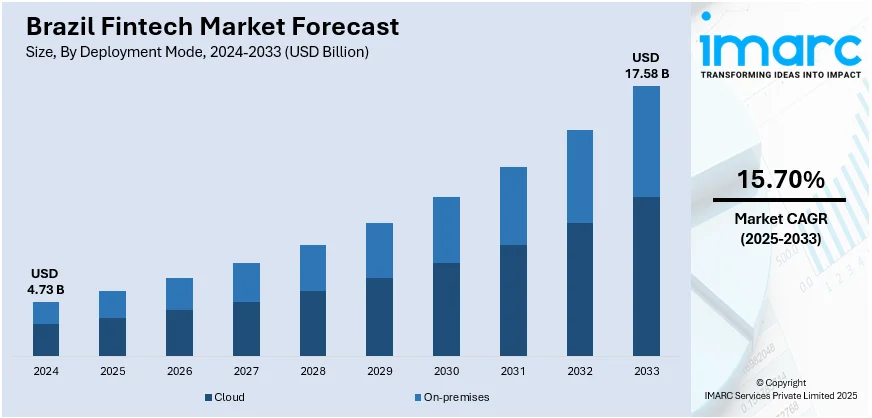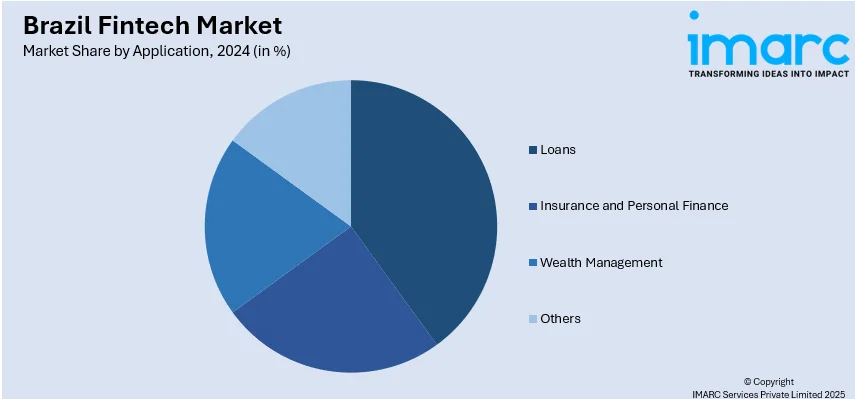
Brazil Fintech Market Size, Share, Trends and Forecast by Deployment Mode, Technology, Application, End User, and Region, 2025-2033
Brazil Fintech Market Overview:
The Brazil fintech market size reached USD 4.73 Billion in 2024. Looking forward, IMARC Group expects the market to reach USD 17.58 Billion by 2033, exhibiting a growth rate (CAGR) of 15.70% during 2025-2033. The rising smartphone penetration, high demand for digital payments, the implementation of open banking policies, increased financial inclusion, rising venture capital investments, and substantial advances in lending platforms are some of the major factors positively impacting Brazil fintech market share.
|
Report Attribute
|
Key Statistics
|
|---|---|
|
Base Year
|
2024
|
|
Forecast Years
|
2025-2033
|
|
Historical Years
|
2019-2024
|
| Market Size in 2024 | USD 4.73 Billion |
| Market Forecast in 2033 | USD 17.58 Billion |
| Market Growth Rate (2025-2033) | 15.70% |
Brazil Fintech Market Trends:
Increasing Smartphone Penetration
The increasing usage of smartphones in Brazil creates a foundation for fintech adoption, which is facilitating Brazil fintech market growth. Consumers now have easy access to digital financial services such as e-wallets, mobile banking and person to person payment systems due to widespread mobile device ownership. According to an industry report, at the beginning of 2024, internet penetration in Brazil was 86.6 percent, with 187.9 Million internet users. For many Brazilians, smartphones serve as their primary means of accessing the internet, making them a critical tool for financial inclusion. Brazil's fintech startups are taking advantage of this by providing mobile-first platforms that let customers apply for loans, move money, and open accounts all from their phones. The convenience of mobile services has significantly reduced the need for physical bank branches, particularly in remote or underserved regions. This has opened up financial services to a large portion of the population who previously lacked access to traditional banking.

High Demand for Digital Payments
The shift towards digital payments has become a key driver of the Brazilian fintech market. Cash usage is rapidly declining in Brazil as more people choose to deal digitally, especially for e-commerce. According to industry reports, digital wallets are used daily by at least 20% of Brazilians and frequently by 21% of them. Digital wallets, due to their quick response (QR) code payments and other innovative solutions, make them more popular, which is also supported by the growth of e-commerce platforms. The Brazilian Central Bank's instant payment system, Pix, is playing a pivotal role in transforming the payment landscape. It allows users to make real-time transactions at any time of day, offering a free and more efficient alternative to traditional payment systems. The success of Pix reflects the growing consumer preference for digital-first solutions, with fintech companies benefiting from increased demand for integrated, user-friendly payment services.
Open Banking Initiatives
Open banking in Brazil is a major factor significantly influencing the Brazil fintech market outlook. According to the latest industry reports, Brazil has the highest open banking adoption rates in the world, with 53.7 Million open finance users, 25% of its adult population. Initiated by the Brazilian Central Bank, with the user's permission, open banking permits third-party financial service providers to access customer banking information. This initiative aims to increase competition among financial institutions and foster innovation by facilitating the process for fintech companies to develop tailored products and services. Open banking also enables seamless integration across platforms, giving customers more authority and openness over their financial information. The initiative has leveled the playing field for fintechs, allowing them to compete more effectively with traditional banks, which have historically dominated the financial sector.
Brazil Fintech Market Segmentation:
IMARC Group provides an analysis of the key trends in each segment of the market, along with forecasts at the regional level for 2025-2033. Our report has categorized the market based on deployment mode, technology, application, and end-user.
Deployment Mode Insights:
- Cloud
- On-premises
The report has provided a detailed breakup and analysis of the market based on the deployment mode. This includes cloud, on-premises.
Technology Insights:
- Application Programming Interface (API)
- Artificial Intelligence (AI)
- Block chain
- Data Analytics
- Robotics Process Automation (RPA)
- Others
A detailed breakup and analysis of the market based on the technology have also been provided in the report. This includes application programming interface (API), artificial intelligence (AI), block chain, data analytics, robotics process automation (APA), and others.
Application Insights:

- Loans
- Insurance and Personal Finance
- Wealth Management
- Others
The report has provided a detailed breakup and analysis of the market based on the application. This includes loans, insurance and personal finance, wealth management, and others.
End User Insights:
- Banking
- Insurance
- Securities
- Others
A detailed breakup and analysis of the market based on the end-user have also been provided in the report. This includes banking, insurance, securities, and others.
Regional Insights:
- Southeast
- South
- Northeast
- North
- Central- West
The report has also provided a comprehensive analysis of all the major regional markets, which include Southeast, South, Northeast, North, and Central-West.
Competitive Landscape:
The market research report has also provided a comprehensive analysis of the competitive landscape. Competitive analysis such as market structure, key player positioning, top winning strategies, competitive dashboard, and company evaluation quadrant has been covered in the report. Also, detailed profiles of all major companies have been provided.
Brazil Fintech Market News:
- September 2024: In a series, Ume, a financial startup based in São Paulo, raised USD 15 Million. PayPal Ventures led an investment round in which Globo Ventures, NFX, and Clocktower Ventures also participated.
- June 2024: The Brazilian FinTech company Celcoin raised USD 125 Million in a funding round that was led by Summit Partners and included participation from previous investors. This investment will help the company achieve its goals of expanding its financial services and innovating.
Brazil Fintech Market Report Coverage:
| Report Features | Details |
|---|---|
| Base Year of the Analysis | 2024 |
| Historical Period | 2019-2024 |
| Forecast Period | 2025-2033 |
| Units | Billion USD |
| Scope of the Report |
Exploration of Historical Trends and Market Outlook, Industry Catalysts and Challenges, Segment-Wise Historical and Future Market Assessment:
|
| Deployment Modes Covered | Cloud, On-premises |
| Technologies Covered | Application Programming Interface (API), Artificial Intelligence (AI), Block chain, Data Analytics, Robotics Process Automation (RPA), Others |
| Applications Covered | Loans, Insurance and Personal Finance, Wealth Management, Others |
| End-Users Covered | Banking, Insurance, Securities, Others |
| Regions Covered | Southeast, South, Northeast, North, Central-West |
| Customization Scope | 10% Free Customization |
| Post-Sale Analyst Support | 10-12 Weeks |
| Delivery Format | PDF and Excel through Email (We can also provide the editable version of the report in PPT/Word format on special request) |
Key Questions Answered in This Report:
- How has the Brazil fintech market performed so far and how will it perform in the coming years?
- What is the breakup of the Brazil fintech market on the basis of deployment mode?
- What is the breakup of the Brazil fintech market on the basis of technology?
- What is the breakup of the Brazil fintech market on the basis of application?
- What is the breakup of the Brazil fintech market on the basis of end user?
- What is the breakup of the Brazil fintech market on the basis of region?
- What are the various stages in the value chain of the Brazil fintech market?
- What are the key driving factors and challenges in the Brazil fintech?
- What is the structure of the Brazil fintech market and who are the key players?
- What is the degree of competition in the Brazil fintech market?
Key Benefits for Stakeholders:
- IMARC’s industry report offers a comprehensive quantitative analysis of various market segments, historical and current market trends, market forecasts, and dynamics of the Brazil fintech market from 2019-2033.
- The research report provides the latest information on the market drivers, challenges, and opportunities in the Brazil fintech market.
- Porter's five forces analysis assist stakeholders in assessing the impact of new entrants, competitive rivalry, supplier power, buyer power, and the threat of substitution. It helps stakeholders to analyze the level of competition within the Brazil fintech industry and its attractiveness.
- Competitive landscape allows stakeholders to understand their competitive environment and provides an insight into the current positions of key players in the market.
Need more help?
- Speak to our experienced analysts for insights on the current market scenarios.
- Include additional segments and countries to customize the report as per your requirement.
- Gain an unparalleled competitive advantage in your domain by understanding how to utilize the report and positively impacting your operations and revenue.
- For further assistance, please connect with our analysts.
 Inquire Before Buying
Inquire Before Buying
 Speak to an Analyst
Speak to an Analyst
 Request Brochure
Request Brochure
 Request Customization
Request Customization




.webp)




.webp)












